Abstract
Drug responses of isolated hemisected frog spinal cords were examined by means of the sucrose-gap technique. The glutamate-induced depolarizations (glu-d) of motoneurones (recorded from ventral roots), and primary afferents (recorded from dorsal roots), were followed by an afterhyperpolarization (glu-a.h.). The depolarization induced by DL-homocysteic acid (DLH) was only occasionally followed by an afterhyperpolarization (DLH-a.h.). The glu-a.h. on both roots persisted in the presence of tetrodotoxin (TTX, 0.1-1 microM), or Ringer solution containing 10 mM-Mg2+; 0.1 mM-Ca2+ or 2 mM-Mn2+; 0.2 mM-Ca2+. This indicated that the response was neither due to the release of endogenous neurally active substances nor to the activation of a Ca2+-sensitive K+ conductance. The glu-a.h. was reduced or blocked by K+-free Ringer solution, 3-acetylstrophanthin (3-Ac-Str; 1 microM) or Li+ ions, and was therefore attributed to the activity of the electrogenic Na+ pump. The duration of depolarization induced by glu or DLH was increased in the presence of K+-free Ringer solution, 1 microM 3-Ac-Str or Li ions. It is therefore suggested that the electrogenic Na+ pump may play a role in limiting the duration of depolarization induced by the action of excitatory amino acids. The re-admission of K+ ions to preparations which had been incubated in K+-free Ringer solution produced a transient hyperpolarization (K-a.h.) of the membrane potential of ventral roots which is also attributable to the activation of the electrogenic Na+ pump. Both the K-a.h. and the glu-a.h. were enhanced in Ca2+-free Ringer solution. It is therefore suggested that the Ca2+ ions may modulate the activity of the electrogenic pump in central nervous tissue.
Full text
PDF
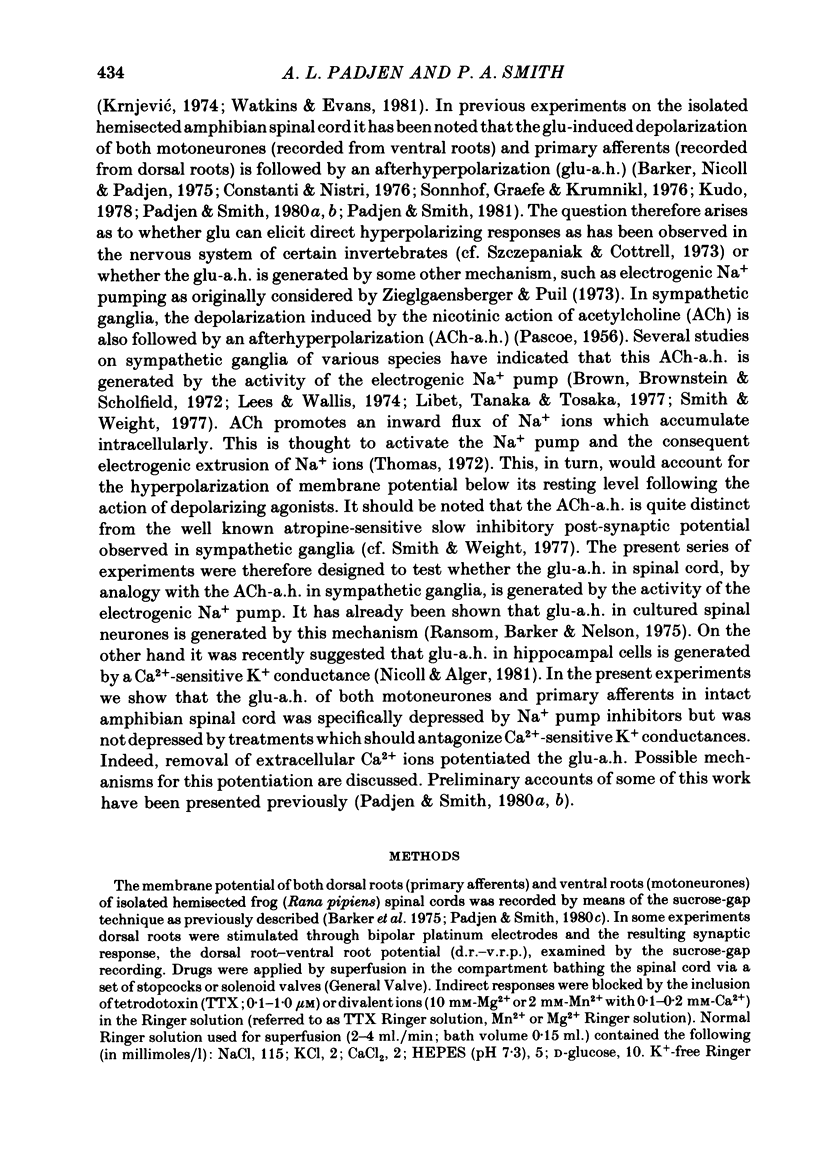


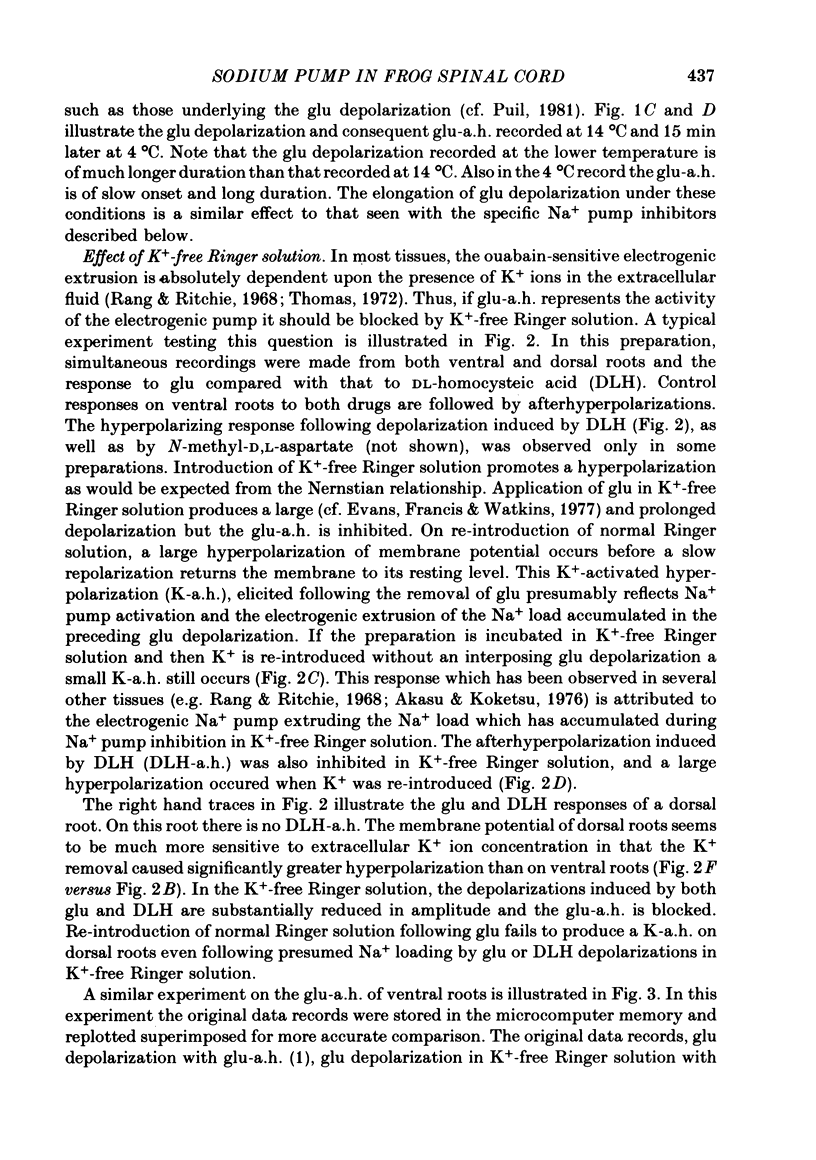

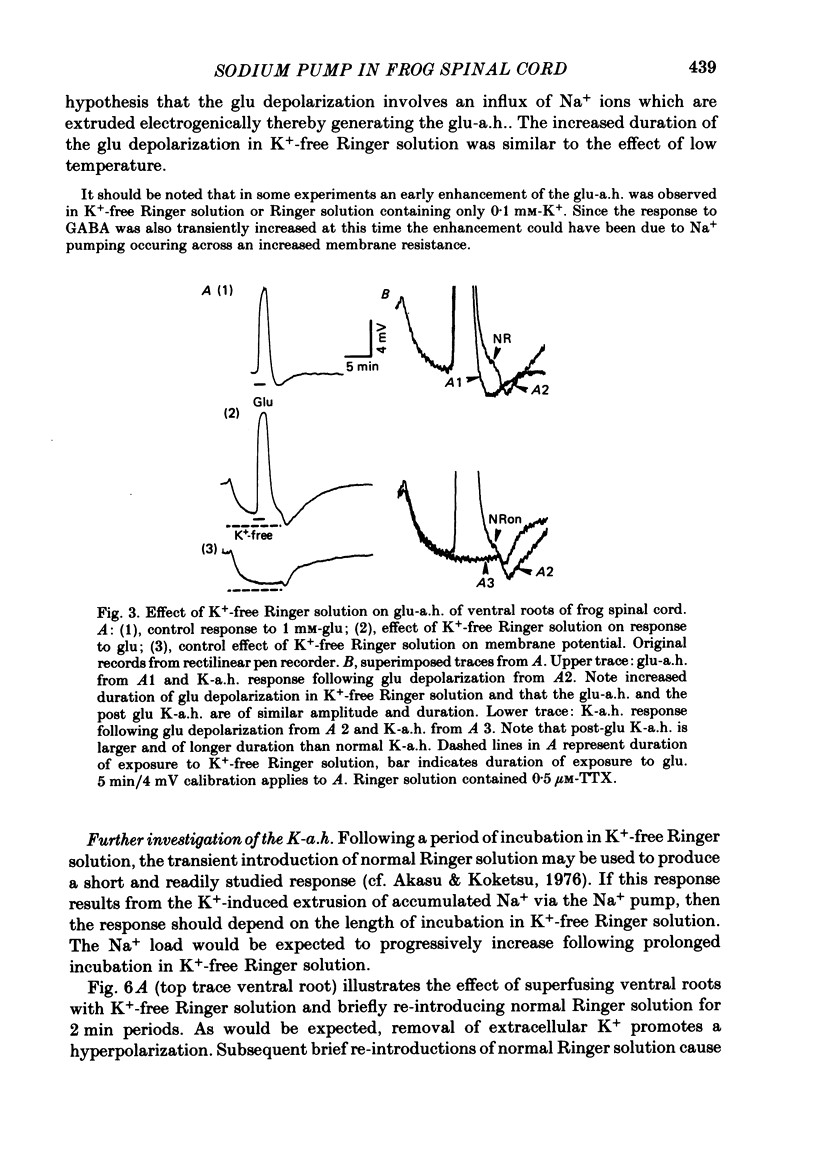

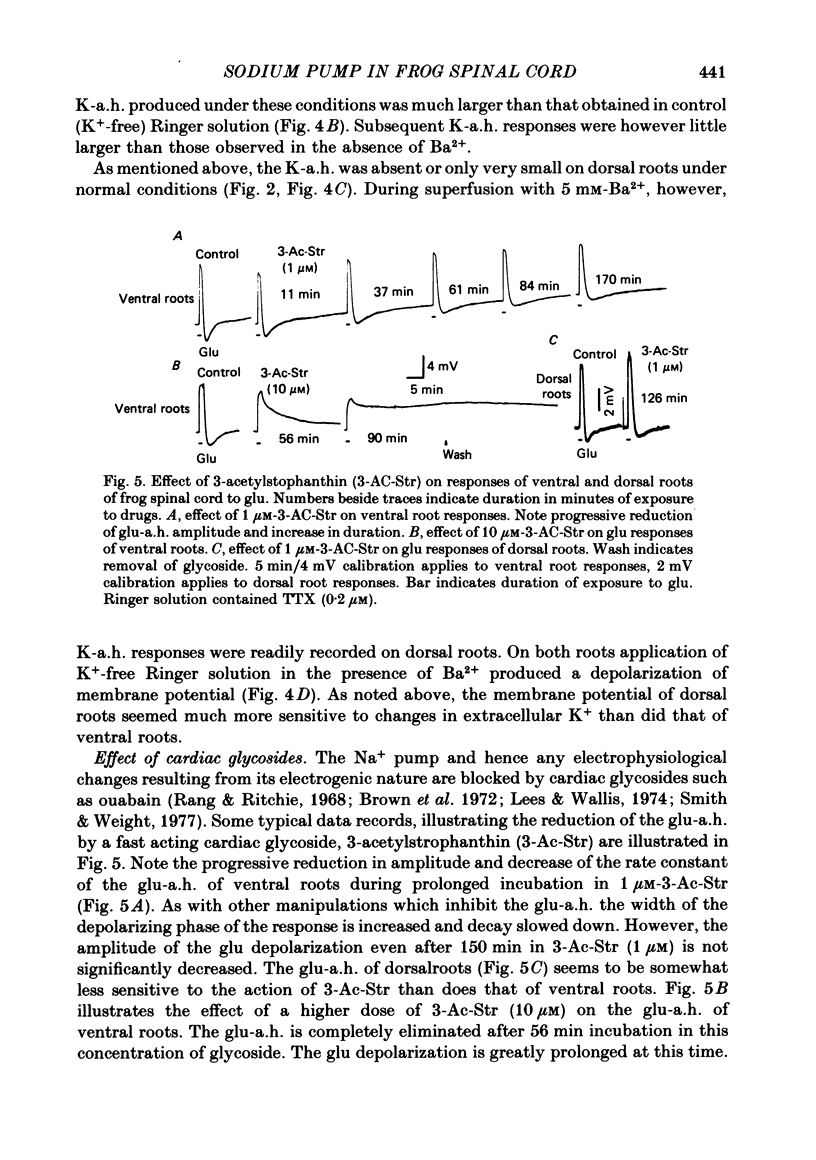


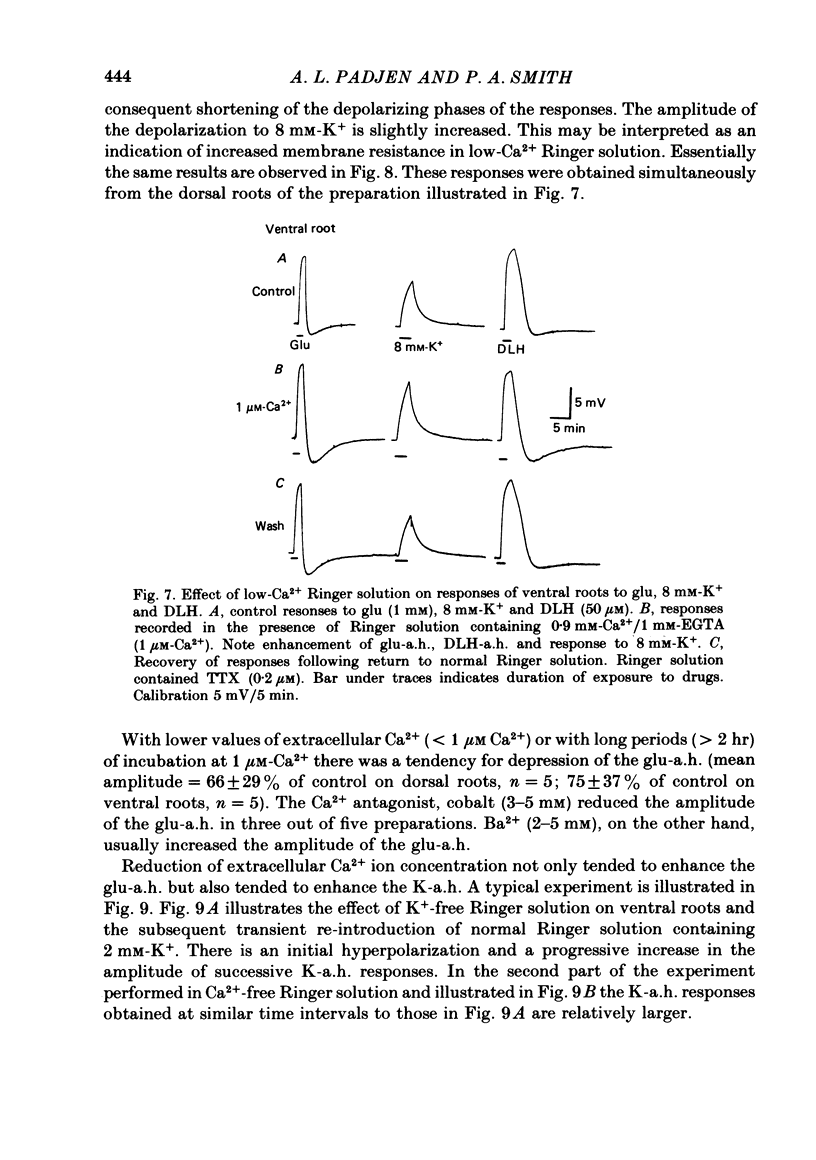



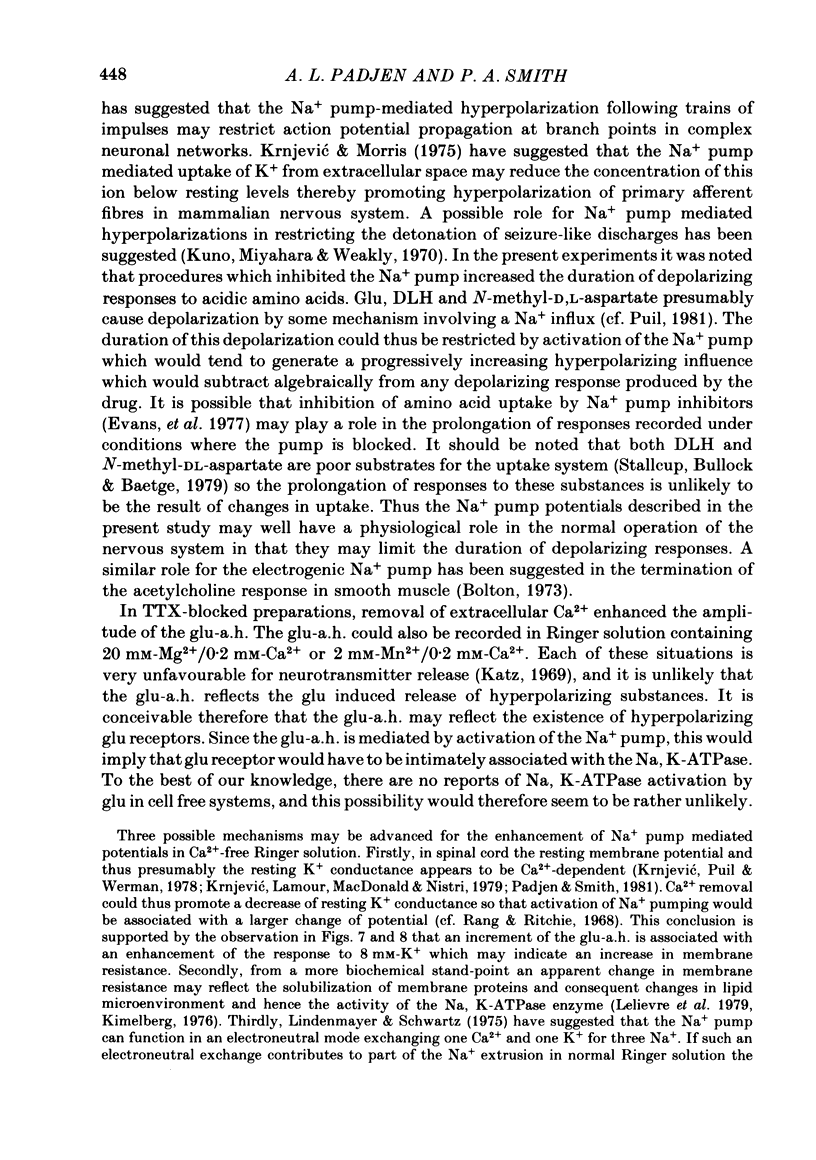
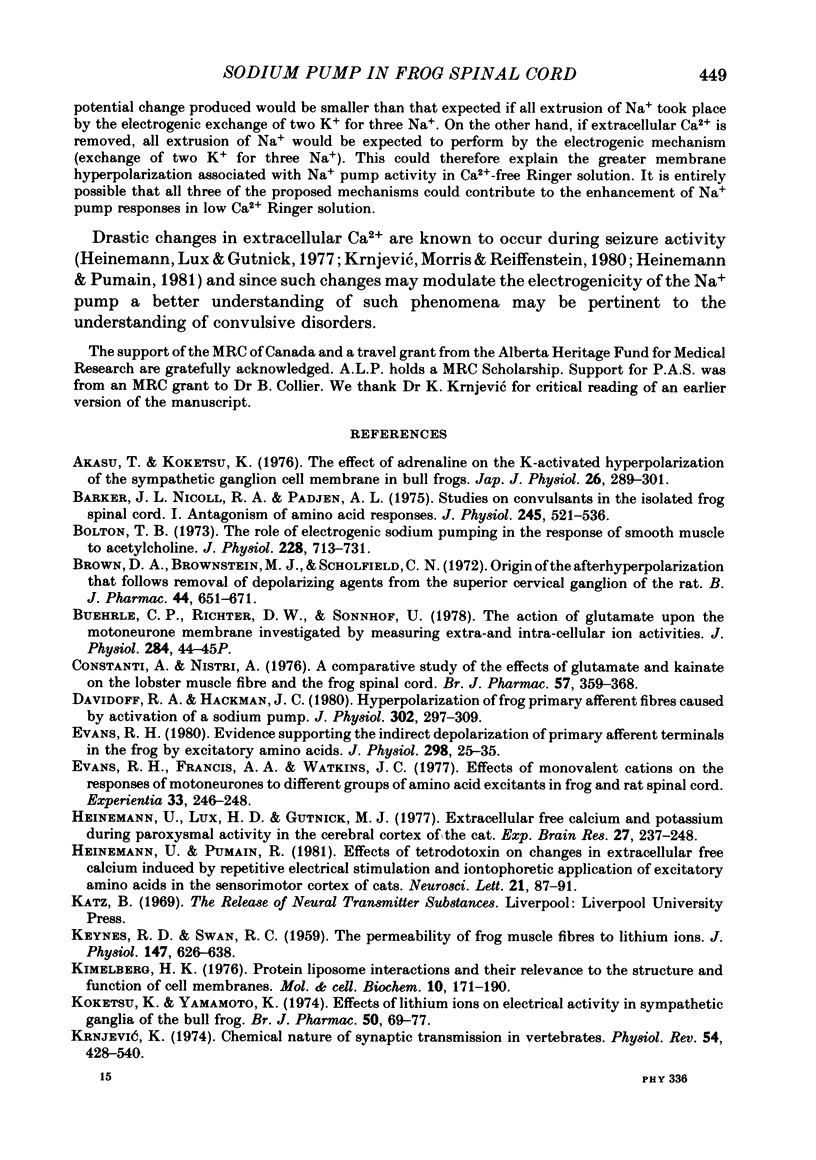

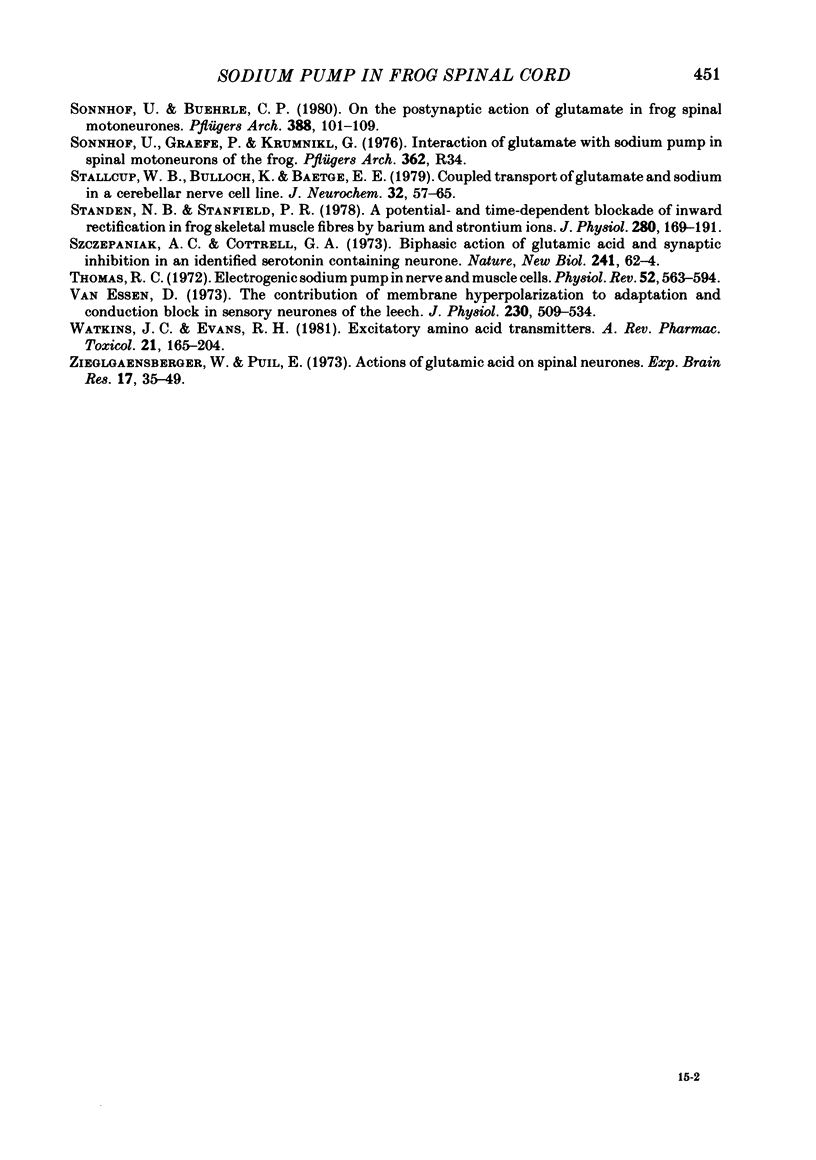
Selected References
These references are in PubMed. This may not be the complete list of references from this article.
- Akasu T., Koketsu K. The effect of adrenaline on the K+ -activated hyperpolarization of the sympathetic ganglion cell membrane in bullfrogs. Jpn J Physiol. 1976;26(3):289–301. doi: 10.2170/jjphysiol.26.289. [DOI] [PubMed] [Google Scholar]
- Barker J. L., Nicoll R. A., Padjen A. Studies on convulsants in the isolated frog spinal cord. I. Antagonism of amino acid responses. J Physiol. 1975 Mar;245(3):521–536. doi: 10.1113/jphysiol.1975.sp010859. [DOI] [PMC free article] [PubMed] [Google Scholar]
- Bolton T. B. The role of electrogenic sodium pumping in the response of smooth muscle to acetylcholine. J Physiol. 1973 Feb;228(3):713–731. doi: 10.1113/jphysiol.1973.sp010108. [DOI] [PMC free article] [PubMed] [Google Scholar]
- Brown D. A., Brownstein M. J., Scholfield C. N. Origin of the after-hyperpolarization that follows removal of depolarizing agents from the isolated superior cervical ganglion of the rat. Br J Pharmacol. 1972 Apr;44(4):651–671. doi: 10.1111/j.1476-5381.1972.tb07305.x. [DOI] [PMC free article] [PubMed] [Google Scholar]
- Bührle C. P., Richter D. W., Sonnhof U. The action of glutamate upon the motoneurone membrane investigated by measuring extra- and intracellular ion activities [proceedings]. J Physiol. 1978 Nov;284:44P–45P. [PubMed] [Google Scholar]
- Constanti A., Nistri A. A comparative study of the effects of glutamate and kainate on the lobster muscle fibre and the frog spinal cord. Br J Pharmacol. 1976 Jul;57(3):359–368. doi: 10.1111/j.1476-5381.1976.tb07674.x. [DOI] [PMC free article] [PubMed] [Google Scholar]
- Davidoff R. A., Hackman J. C. Hyperpolarization of frog primary afferent fibres caused by activation of a sodium pump. J Physiol. 1980 May;302:297–309. doi: 10.1113/jphysiol.1980.sp013243. [DOI] [PMC free article] [PubMed] [Google Scholar]
- Evans R. H. Evidence supporting the indirect depolarization of primary afferent terminals in the frog by excitatory amino acids. J Physiol. 1980 Jan;298:25–35. doi: 10.1113/jphysiol.1980.sp013064. [DOI] [PMC free article] [PubMed] [Google Scholar]
- Evans R. H., Francis A. A., Watkins J. C. Effects of monovalent cations on the responses of motoneurones to different groups to amino acid excitants in frog and rat spinal cord. Experientia. 1977 Feb 15;33(2):246–248. doi: 10.1007/BF02124092. [DOI] [PubMed] [Google Scholar]
- Heinemann U., Lux H. D., Gutnick M. J. Extracellular free calcium and potassium during paroxsmal activity in the cerebral cortex of the cat. Exp Brain Res. 1977 Mar 30;27(3-4):237–243. doi: 10.1007/BF00235500. [DOI] [PubMed] [Google Scholar]
- Heinemann U., Pumain R. Effects of tetrodotoxin on changes in extracellular free calcium induced by repetitive electrical stimulation and iontophoretic application of excitatory amino acids in the sensorimotor cortex of cats. Neurosci Lett. 1981 Jan 1;21(1):87–91. doi: 10.1016/0304-3940(81)90063-x. [DOI] [PubMed] [Google Scholar]
- KEYNES R. D., SWAN R. C. The permeability of frog muscle fibres to lithium ions. J Physiol. 1959 Oct;147:626–638. doi: 10.1113/jphysiol.1959.sp006265. [DOI] [PMC free article] [PubMed] [Google Scholar]
- Kimelberg H. K. Protein-liposome interactions and their relevance to the structure and function of cell membranes. Mol Cell Biochem. 1976 Feb 25;10(3):171–190. doi: 10.1007/BF01731688. [DOI] [PubMed] [Google Scholar]
- Koketsu K., Yamamoto K. Effects of lithium ions on electrical activity in sympathetic ganglia of the bullfrog. Br J Pharmacol. 1974 Jan;50(1):69–77. doi: 10.1111/j.1476-5381.1974.tb09594.x. [DOI] [PMC free article] [PubMed] [Google Scholar]
- Krnjević K., Lamour Y., MacDonald J. F., Nistri A. Effects of some divalent cations on motoneurones in cats. Can J Physiol Pharmacol. 1979 Sep;57(9):944–956. doi: 10.1139/y79-144. [DOI] [PubMed] [Google Scholar]
- Krnjević K., Morris M. E. Factors determining the decay of K+ potentials and focal potentials in the central nervous system. Can J Physiol Pharmacol. 1975 Oct;53(5):923–934. doi: 10.1139/y75-126. [DOI] [PubMed] [Google Scholar]
- Krnjević K., Morris M. E., Reiffenstein R. J. Changes in extracellular Ca2+ and K+ activity accompanying hippocampal discharges. Can J Physiol Pharmacol. 1980 May;58(5):579–582. doi: 10.1139/y80-097. [DOI] [PubMed] [Google Scholar]
- Krnjević K., Puil E., Werman R. Significance of 2,4-dinitrophenol action on spinal motoneurones. J Physiol. 1978 Feb;275:225–239. doi: 10.1113/jphysiol.1978.sp012187. [DOI] [PMC free article] [PubMed] [Google Scholar]
- Krnjević K., Pumain R., Renaud L. Effects of Ba2+ and tetraethylammonium on cortical neurones. J Physiol. 1971 May;215(1):223–245. doi: 10.1113/jphysiol.1971.sp009466. [DOI] [PMC free article] [PubMed] [Google Scholar]
- Kudo Y. The pharmacology of the amphibian spinal cord. Prog Neurobiol. 1978;11(1):1–76. doi: 10.1016/0301-0082(78)90007-2. [DOI] [PubMed] [Google Scholar]
- Kuno M., Miyahara J. T., Weakly J. N. Post-tetanic hyperpolarization produced by an electrogenic pump in dorsal spinocerebellar tract neurones of the cat. J Physiol. 1970 Nov;210(4):839–855. doi: 10.1113/jphysiol.1970.sp009245. [DOI] [PMC free article] [PubMed] [Google Scholar]
- Lees G. M., Wallis D. I. Hyperpolarization of rabbit superior cervical ganglion cells due to activity of an electrogenic sodium pump. Br J Pharmacol. 1974 Jan;50(1):79–93. doi: 10.1111/j.1476-5381.1974.tb09595.x. [DOI] [PMC free article] [PubMed] [Google Scholar]
- Lelievre L., Zachowski A., Charlemagne D., Laget P., Paraf A. Inhibition of (Na+ + K+)-ATPase by ouabain: involvement of calcium and membrane proteins. Biochim Biophys Acta. 1979 Nov 2;557(2):399–408. doi: 10.1016/0005-2736(79)90338-9. [DOI] [PubMed] [Google Scholar]
- Lindenmayer G. E., Schwartz A. A kinetic characterization of calcium on (Na+ + K+)-ATPase and its potential role as a link between extracellular and intracellular events: hypothesis for digitalis-induced inotropism. J Mol Cell Cardiol. 1975 Aug;7(8):591–612. doi: 10.1016/0022-2828(75)90117-0. [DOI] [PubMed] [Google Scholar]
- Meech R. W. Calcium-dependent potassium activation in nervous tissues. Annu Rev Biophys Bioeng. 1978;7:1–18. doi: 10.1146/annurev.bb.07.060178.000245. [DOI] [PubMed] [Google Scholar]
- Minota S. Calcium ions and the post-tetanic hyperpolarization of bullfrog sympathetic ganglion cells. Jpn J Physiol. 1974 Oct;24(5):501–512. doi: 10.2170/jjphysiol.24.501. [DOI] [PubMed] [Google Scholar]
- Nicoll R. A., Alger B. E. Synaptic excitation may activate a calcium-dependent potassium conductance in hippocampal pyramidal cells. Science. 1981 May 22;212(4497):957–959. doi: 10.1126/science.6262912. [DOI] [PubMed] [Google Scholar]
- PASCOE J. E. The effects of acetylcholine and other drugs on the isolated superior cervical ganglion. J Physiol. 1956 Apr 27;132(1):242–255. doi: 10.1113/jphysiol.1956.sp005519. [DOI] [PMC free article] [PubMed] [Google Scholar]
- PORTZEHL H., CALDWELL P. C., RUEEGG J. C. THE DEPENDENCE OF CONTRACTION AND RELAXATION OF MUSCLE FIBRES FROM THE CRAB MAIA SQUINADO ON THE INTERNAL CONCENTRATION OF FREE CALCIUM IONS. Biochim Biophys Acta. 1964 May 25;79:581–591. doi: 10.1016/0926-6577(64)90224-4. [DOI] [PubMed] [Google Scholar]
- Padjen A. L., Smith P. A. Possible role of divalent cations in amino acid responses of frog spinal cord. Adv Biochem Psychopharmacol. 1981;29:271–280. [PubMed] [Google Scholar]
- Padjen A. L., Smith P. A. Specific effects of alpha-D,L-aminoadipic acid on synaptic transmission in frog spinal cord. Can J Physiol Pharmacol. 1980 Jun;58(6):692–698. doi: 10.1139/y80-111. [DOI] [PubMed] [Google Scholar]
- Puil E. S-Glutamate: its interactions with spinal neurons. Brain Res. 1981 Dec;228(3):229–322. doi: 10.1016/0165-0173(81)90007-2. [DOI] [PubMed] [Google Scholar]
- Pumain R., Heinemann U. Extracellular calcium and potassium changes in mammalian neocortex. Adv Biochem Psychopharmacol. 1981;29:53–58. [PubMed] [Google Scholar]
- Rang H. P., Ritchie J. M. On the electrogenic sodium pump in mammalian non-myelinated nerve fibres and its activation by various external cations. J Physiol. 1968 May;196(1):183–221. doi: 10.1113/jphysiol.1968.sp008502. [DOI] [PMC free article] [PubMed] [Google Scholar]
- Ransom B. R., Barker J. L., Nelson P. G. Two mechanisms for poststimulus hyperpolarisations in cultured mammalian neurones. Nature. 1975 Jul 31;256(5516):424–425. doi: 10.1038/256424a0. [DOI] [PubMed] [Google Scholar]
- Sjodin R. A., Ortiz O. Resolution of the potassium ion pump in muscle fibers using barium ions. J Gen Physiol. 1975 Sep;66(3):269–286. doi: 10.1085/jgp.66.3.269. [DOI] [PMC free article] [PubMed] [Google Scholar]
- Smith P. A., Weight F. F. Role of electrogenic sodium pump in slow synaptic inhibition is re-evaluated. Nature. 1977 May 5;267(5606):68–70. doi: 10.1038/267068a0. [DOI] [PubMed] [Google Scholar]
- Sonnhof U., Bührle C. P. On the postsynaptic action of glutamate in frog spinal motoneurons. Pflugers Arch. 1980 Nov;388(2):101–109. doi: 10.1007/BF00584115. [DOI] [PubMed] [Google Scholar]
- Stallcup W. B., Bulloch K., Baetge E. E. Coupled transport of glutamate and sodium in a cerebellar nerve cell line. J Neurochem. 1979 Jan;32(1):57–65. doi: 10.1111/j.1471-4159.1979.tb04509.x. [DOI] [PubMed] [Google Scholar]
- Standen N. B., Stanfield P. R. A potential- and time-dependent blockade of inward rectification in frog skeletal muscle fibres by barium and strontium ions. J Physiol. 1978 Jul;280:169–191. doi: 10.1113/jphysiol.1978.sp012379. [DOI] [PMC free article] [PubMed] [Google Scholar]
- Szczepaniak A. C., Cottrell G. A. Biphasic action of glutamic acid and synpatic inhibition in an identified serotonin-containing neurone. Nat New Biol. 1973 Jan 10;241(106):62–64. doi: 10.1038/newbio241062a0. [DOI] [PubMed] [Google Scholar]
- Thomas R. C. Electrogenic sodium pump in nerve and muscle cells. Physiol Rev. 1972 Jul;52(3):563–594. doi: 10.1152/physrev.1972.52.3.563. [DOI] [PubMed] [Google Scholar]
- Van Essen D. C. The contribution of membrane hyperpolarization to adaptation and conduction block in sensory neurones of the leech. J Physiol. 1973 May;230(3):509–534. doi: 10.1113/jphysiol.1973.sp010201. [DOI] [PMC free article] [PubMed] [Google Scholar]
- Watkins J. C., Evans R. H. Excitatory amino acid transmitters. Annu Rev Pharmacol Toxicol. 1981;21:165–204. doi: 10.1146/annurev.pa.21.040181.001121. [DOI] [PubMed] [Google Scholar]
- Zieglgänsberger W., Puil E. A. Actions of glutamic acid on spinal neurones. Exp Brain Res. 1973 Mar 29;17(1):35–49. doi: 10.1007/BF00234562. [DOI] [PubMed] [Google Scholar]


